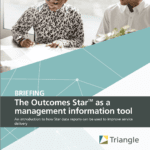
The Outcomes Star is well established as a tool for supporting effective keywork and demonstrating achievements. Here, 'Triangle's Research Analyst, Dr Anna Good, discusses a third benefit, the opportunity for internal learning. This new briefing describes how Star data can be used to improve service delivery.
Learning from Star data at all levels of the organisation
Over three-quarters of Outcomes Star users in our client survey said Star data reports were ‘useful for learning how their service was ‘doing’ and ‘helpful in managing or developing the ‘service’. Indeed, Star data can provide meaningful management information at all levels, from a service manager reviewing a single ‘worker’s caseload to a senior management team reviewing data aggregated across services.
Alongside other data (e.g. satisfaction surveys, output and process data), Star data reports, such as those available from our upgraded Star Online System, allow organisations to ask increasingly focused questions about what is happening with the people they support.
Managers can gain essential insights by looking at differences in starting points and change across outcome areas, client groups, and service settings. Because these insights are likely to be greatest when compared against prior expectations, Triangle has produced resources to support ‘Star data ‘forecasting’.
Learning from Initial Star readings
The distribution of first Star readings provides a valuable overview of people’s needs coming into the service. Star readings can be compared against expectations to ensure that service users are entering the service appropriately and are offered suitable interventions.
An excellent example of the use of first readings is in Staffordshire County Council, where they look at start readings to see if the families are at the right level of service. In our interview with the Commissioning Manager at the time, she told us that “if we have families in our Family Intervention service that have readings of five, I look a bit deeper to see if we’re really using our resources correctly”.
Learning from change in Star readings
Movement in Star readings for each outcome area also provides an opportunity to learn where things are going well and when further exploration of service delivery may be warranted.
For example, if one service shows different outcomes to another service, this is a starting point for further investigation:
- Is there other evidence that one service facilitates better outcomes than another?
- Are there reasons why one service might be supporting people better than another?
- Is the service user profile different in the different services?
- Is practice significantly different in that service, and might there be lessons for other services?
A more in-depth analysis of the movement from each Journey of Change stage is also possible, offering more significant potential for learning than typical numerical outcome scales. Managers can explore which stage transitions are happening frequently and where there may be blockages to making other transitions. For example, a service may be very good at helping service users to begin accepting help but struggle more with moving them towards greater self-reliance, limiting the progress currently being made. Specific changes to service delivery might then need to be developed.
*****
Please download our new briefing, ‘The Outcomes Star as a management information tool‘ for more detail on how Star data reports can be used to improve service delivery. If you would like more information or support about the use of Star data, please get in touch with us at info@outcomesstar.org or +44 (0) 207 272 8765.


